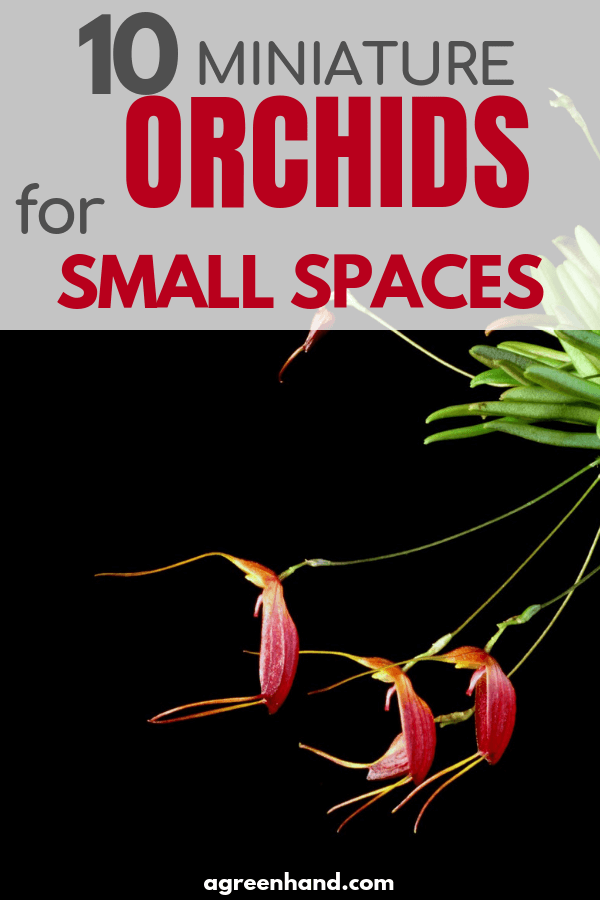Running out of room for your plants? These miniature orchids are perfect for collectors with limited space.
Miniature orchids are popping up in home improvement and garden stores across the country. The most common miniatures those stores offer are hybridized Phalaenopsis orchids, but fans of the diminutive plants can easily find other small orchid species online or with their local breeders.
Miniature orchids are especially ideal for enthusiasts with limited growing space or planted terrariums.
If you decide to grow one of these miniatures, be sure to research a species before making any purchases. Keeping these plants in the right conditions is critical because their small size decreases their ability to adjust to improper temperature, light, and moisture levels.
These ten species are only a few of the hundreds of miniatures available, so gardeners can almost certainly find a species that is suited to their environment.
This plant’s common name, “The Sparkling Trisetella,” references its tiny flowers. The blooms, which average only 2cm across, are covered in thousands of fine red hairs that sparkle when exposed to light.
Trisetella gemmata is a cool- to cold-growing epiphyte that is native to Colombia. If you live in a warm environment, consider growing this species in a temperature-controlled terrarium or in a cool spot in your home.
This flower, too, is native to Colombia. Unlike Trisetella gemmata, though, this orchid requires higher temperatures to thrive. Flowers are usually 10-12mm and tend to dwarf the rest of the plant. Lepanthes telipogoniflora is an epiphyte, which means it grows very well on mounts with its roots draped with a layer of moss.
If you decide to grow one of these orchids, be sure to use only reverse osmosis water or rainwater when caring for the plant: they should never dry completely between waterings and are especially sensitive to mineral salts.
Also referred to as Haraella odorata, this Taiwanese orchid thrives in a wide range of conditions. Flowers are yellow, white, and purple and are faintly scented. This species is most often grown mounted and can tolerate warm to cold temperatures.
If you decide to grow this species on a mount, be sure to water frequently to prevent its roots from drying out. Haraella retrocalla grows best in humid environments.
This tiny orchid is known by several different names. Its most common name, Elongatia guttata, comes from the Latin word for “spotted” and references the speckled purple blooms.
This plant is part of the Pleurothallis alliance and favors warm- to hot-growing conditions. Most collectors grow these orchids on mounts that show off their pendant flowers, but they can be grown in pots with a free-draining potting mix.
If you are looking for a really tiny orchid species, this plant may be the one for you. Its flowers are usually no bigger than a mere 1.25cm and the plant itself typically only grows to be 4″ tall. Mature plants put out long sprays of fragrant white-and-purple blossoms.
Although orchids from the genus Corybas are hard to come by in the United States, they are widely available in Australia, New Zealand, Malaysia, Sumatra, and other surrounding countries where they grow wild. This particular Corybas orchid is truly tiny: its red flowers average a mere 2cm in size and an entire plant typically consists of one leaf and a single bloom.
These terrestrial orchids are typically grown only by collectors who keep them in constantly moist, sandy soil.
This hot-growing epiphyte is native to Ecuador. Its individual flowers are minuscule, but blooms grow in comparatively large, round clusters that look like bursting fireworks.
Blooms are generally pink and white, and mature plants can put out numerous inflorescences. They require low light and high humidity to bloom.
Like Trisetella gemmata, this species is native to South America. It is an epiphyte that grows in the cloud forests of Panama, where it grows in indirect light in a climate that offers intermediate temperatures and very high humidity.
Trisetella dressleri is almost always grown on a mount and requires daily watering. Blooms are about 5mm in size and are red and yellow in color.
This diminutive orchid is so small that renowned orchid retailer Andy’s Orchids classifies it as a “micro-miniature.” Laelia liliputana is a lithophyte but is typically grown in pots instead of on stone mounts. Like other laelias, this species requires very bright to full sun to bloom and can thrive in a broad range of temperatures.
The plant’s pseudobulbs grow to be about one inch in height, including the leaves, and the comparatively large flowers are either white or lavender in color.
This is a truly tiny species of orchid. Commonly called “The Smallest Bulbophyllum” or “The Red Bead Orchid” Bulbophyllum moniliforme produces minuscule pseudobulbs and red flowers that can be as small as 1mm. This plant is a warm- to hot-growing epiphyte or lithophyte that grows in tropical climates in the Southern hemisphere.
